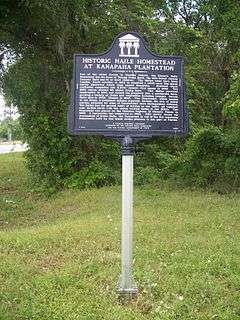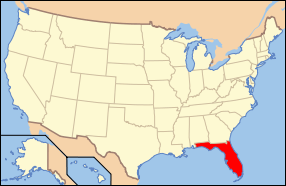Haile Homestead
|
Kanapaha | |
|
Historic marker near Kanapaha Plantation house | |
  | |
| Location | Gainesville, Florida |
|---|---|
| Coordinates | 29°35′40″N 82°26′7″W / 29.59444°N 82.43528°WCoordinates: 29°35′40″N 82°26′7″W / 29.59444°N 82.43528°W |
| NRHP Reference # | 86000915[1] |
| Added to NRHP | May 2, 1986 |
The Haile Homestead, also known as Haile Plantation House or Kanapaha, is a historic site and museum in Gainesville, Florida, United States. It is located at 8500 SR 24. On May 2, 1986, the plantation house was added to the U.S. National Register of Historic Places.
History
In 1854 Thomas Evans Haile, his wife, Esther "Serena" Chesnut Haile, moved from Camden, South Carolina to Alachua County, Florida. There they established a 1,500-acre Sea Island cotton plantation called Kanapaha, meaning "small thatched houses".[2] The Hailes survived bankruptcy in 1868 and turned the property into a productive farm, growing a variety of fruits and vegetables, including oranges.
Evans Haile became the owner of the land but lived in town, and after 1900 the home sat vacant for decades.
Architecture
Officially known as Historic Haile Homestead at Kanapaha Plantation, the house was built for Thomas Evans and Serena Chesnut Haile in 1856 as part of their original 1,500-acre (6.1 km2) cotton plantation. The Hailes brought with them from South Carolina fifty-six slaves who lived in small one-room frame houses for the slaves. Billy Watts was a skilled carpenter who supervised most of the homestead construction. Henry Gaines, a stonemason from the Stringfellow plantation, was responsible for buildin the fireplaces, chimneys and support piers on the plantation. Johnson Chestnut was a gifted carpenter and furniture maker.[2]
Four-foot-tall piers of mortared limerock support a foundation of 100-foot-long beams. The house is constructed of pine with cypress siding.[2]
The house is noted for the writings on its walls by members of the family.
In the late 1980s, the Haile family partnered with the Alachua Conservation Trust to restore the house. Projects include replacing the structure’s current shake-shingle roof.[3] The museum is open for tours on weekends.
-

Haile Homestead
-

Another view
References
- ↑ National Park Service (2010-07-09). "National Register Information System". National Register of Historic Places. National Park Service.
- 1 2 3 "History", Historic Haile Homestead
- ↑ "Historic Haile Homestead", Alachua Conservation Trust
External links
- Historic Haile Homestead at Kanapaha Plantation - official website
- Alachua County listings at National Register of Historic Places
- Alachua County listings Florida's Office of Cultural and Historical Programs
- Historic Haile Homestead at Kanapaha Plantation at Historic Homes of Greater Gainesville


